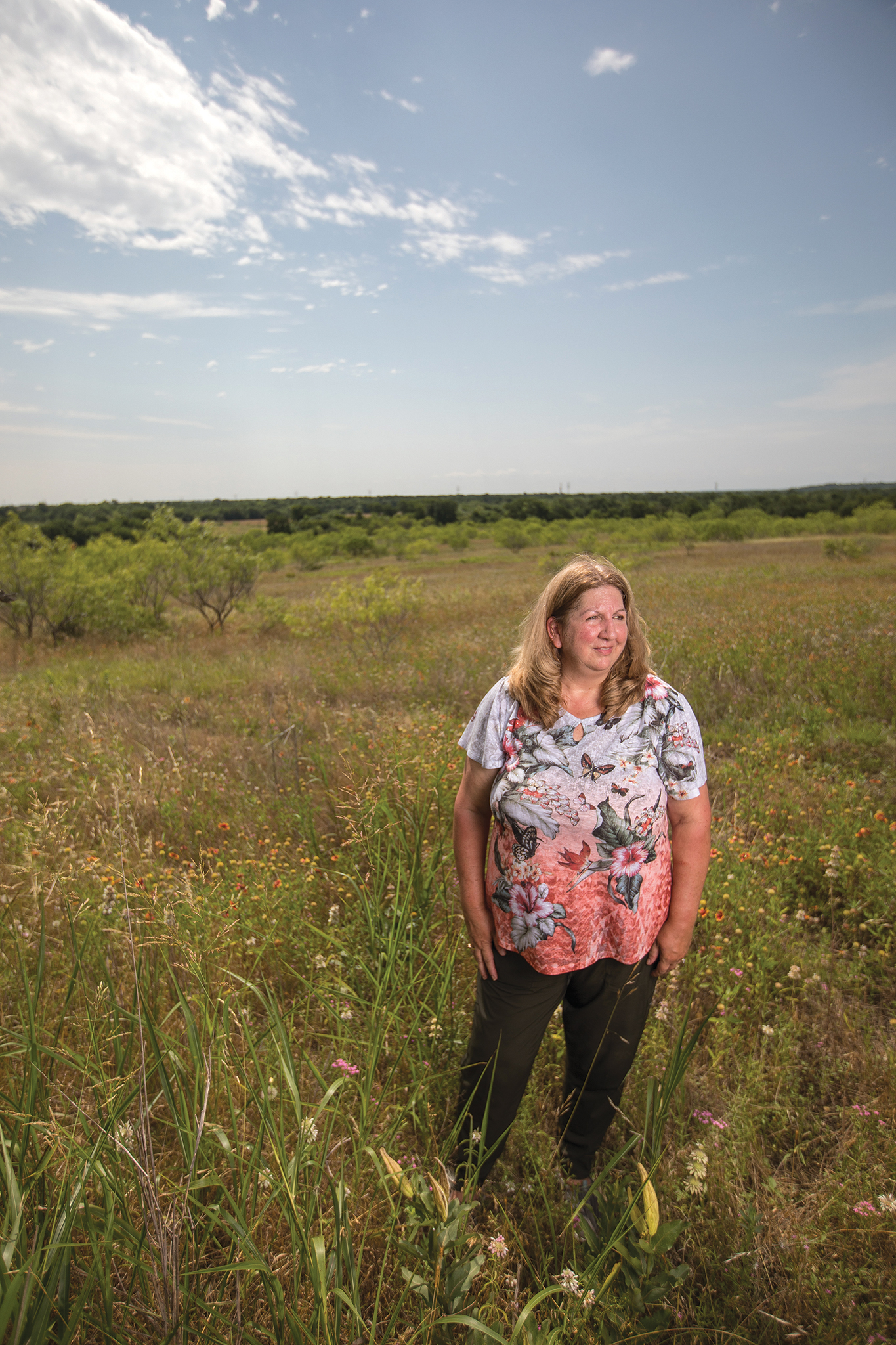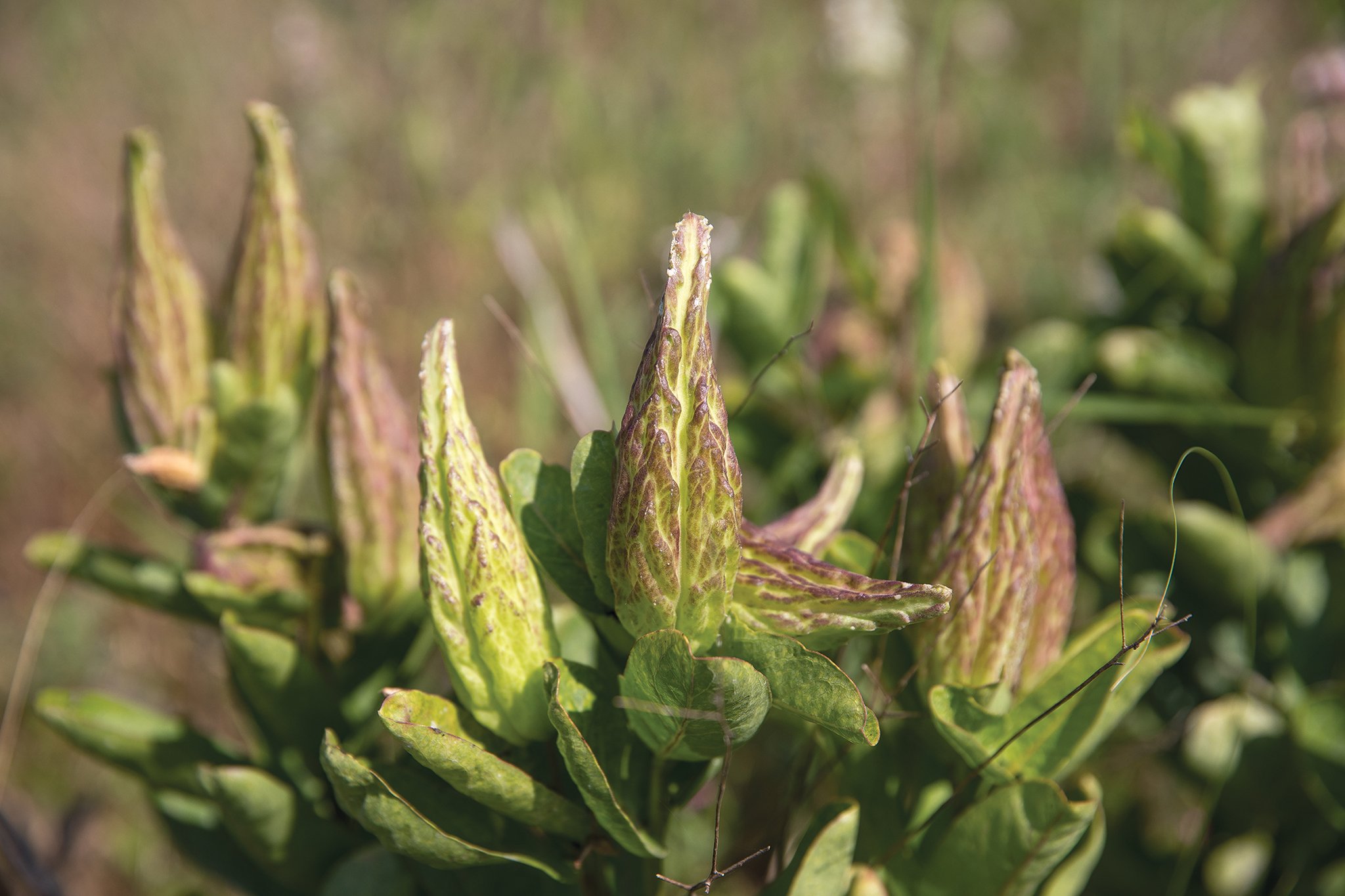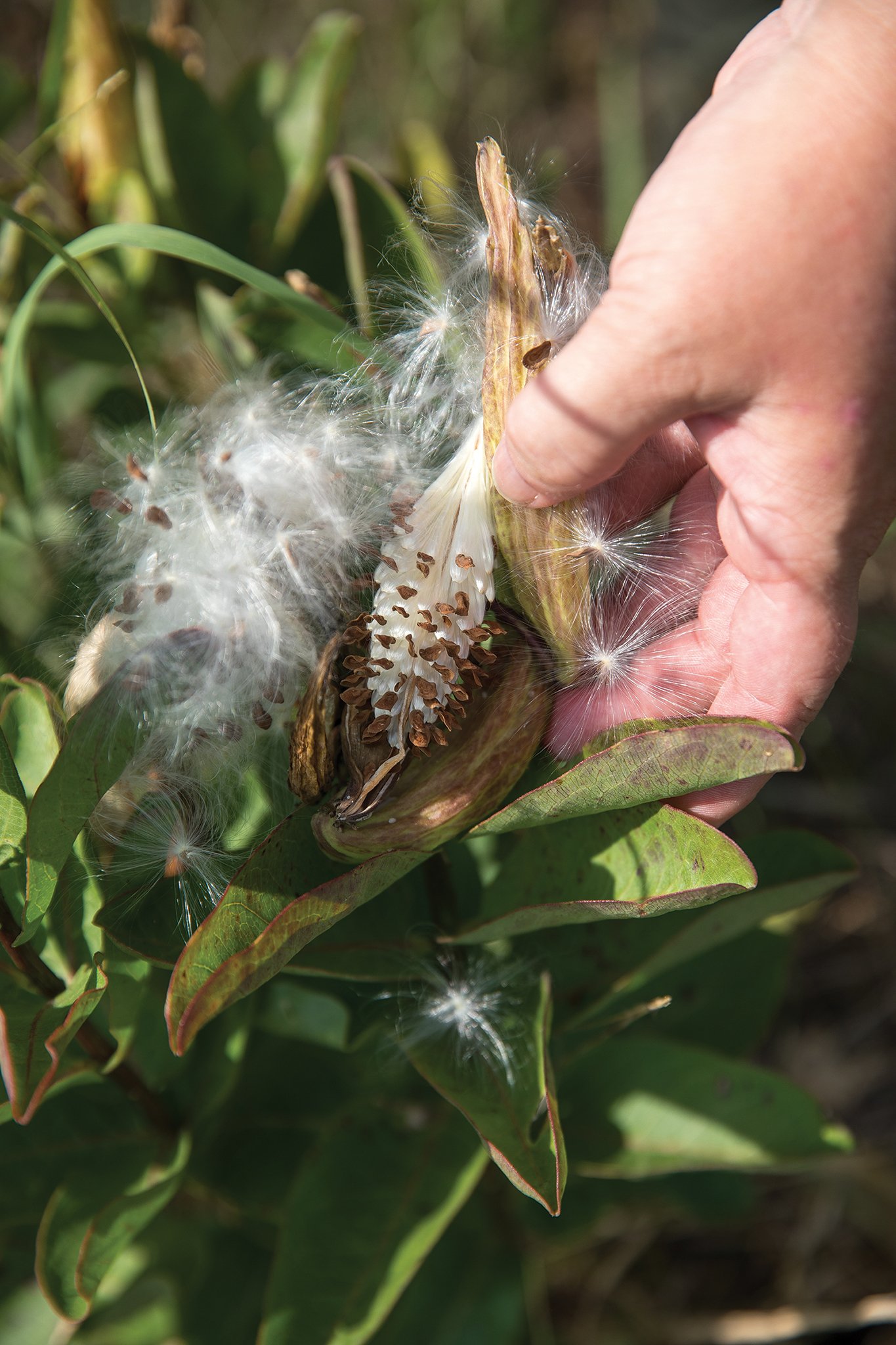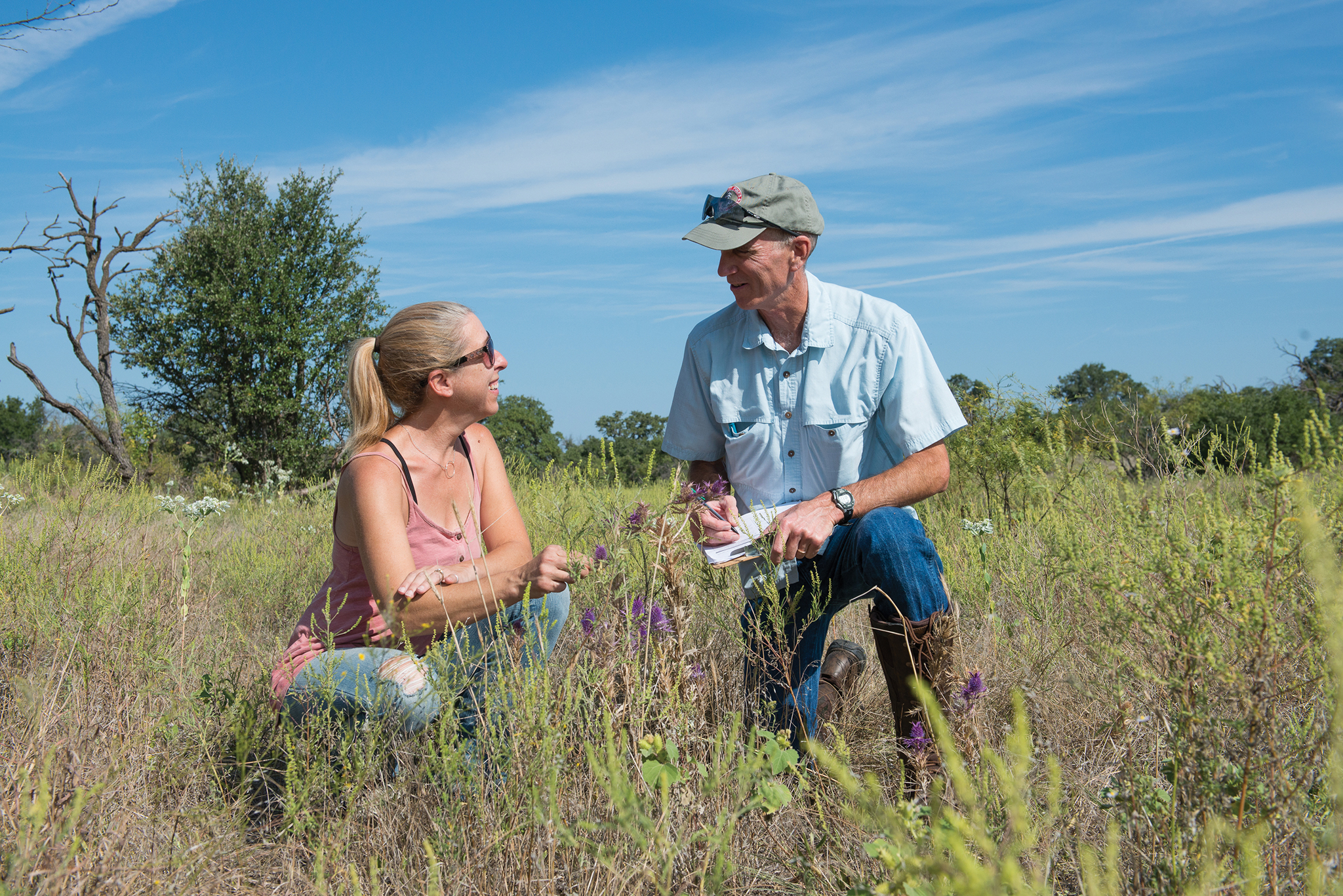
As monarch populations continue to decline, a grassroots movement of native milkweed stewards is emerging across Texas.

by Lindsay Stafford Mader
August 12, 2019
Barbara Keller-Willy remembers her reaction when fellow Texas gardeners told her that native milkweed, a plant essential for the survival of the monarch butterfly, was nearly impossible to grow: How hard could it be? It was 2009, and Keller-Willy had just quit her job as an engineering executive. She was spending her time volunteering for local nature and prairie restoration projects.
Keller-Willy had been a corporate problem-solver for most of her professional career. Learning that milkweed was resistant to even the most green-thumbed growers’ coaxing only tempted her to confront the challenge. So she planted 300 seeds at her home in Sugar Land. Only three survived. “It was sobering,” she says. “It made me think this isn’t as easy as I thought it was going to be.”

For the last two decades, gardeners and butterfly enthusiasts have been trying to grow native milkweed to help monarch butterflies, which lay their eggs exclusively on the plant and depend on it for food. Monarchs are revered throughout North and Central America for their beauty, ability to pollinate many wildflowers and sophisticated two-way migration, unique among butterflies. But since the 1990s, monarch numbers have declined by 90 percent, and advocates are urging the federal government to put the butterfly on the endangered species list. Research has found that the eastern population of monarchs—the one that migrates through Texas—has an 11 to 57 percent chance over the next two decades of reaching numbers so low that it may never recover.
The major culprits are well known: climate change, pesticides and herbicides, deforestation in the mountains of Mexico and a dwindling supply of milkweed, which is also the source of the butterfly’s toxicity to predators. For the monarch’s survival, a plentiful crop of milkweed in Texas is essential. Most monarchs, migrating northward from Mexico, land here every spring to lay the eggs of the first of four generations required to complete the species’ annual migration cycle.
“If we don’t have monarchs in Texas,” Keller-Willy says, “nobody in the [eastern] United States will have monarchs.” Most scientists agree a massive, multifaceted effort is needed. Forests need to be protected from logging in Mexico. Harmful insecticides and herbicides should be abandoned. Climate change must be curbed. But it’s the resurrection of milkweed that seems most within reach. An unlikely evangelist, Keller-Willy has developed a detailed method for growing the finicky plant; gardeners and groups across Texas are picking it up, while others are trying their own strategies. Everyone has the same lingering question: Can we save the monarch before it’s too late?

Growing native milkweed, especially on a large scale, has historically proven difficult. According to Karen Clary, former director of plant conservation at the Lady Bird Johnson Wildflower Center, native Texas milkweed had so long been considered a noxious weed that when people started trying to grow it for monarchs, nobody knew its specific needs.
And while many people have delighted in growing tropical milkweed—an easy-to-grow, colorful species commonly sold in nurseries—research suggests that its yearlong availability may actually be harmful, increasing the prevalence of a damaging parasite and distorting the butterflies’ innate breeding and migration processes. This is why Texans are working hard to increase native milkweed availability around the state.

After Keller-Willy’s first flop with milkweed, she embarked on a crash course in milkweed propagation. While visiting libraries and speaking with researchers, she was surprised to encounter sparse information about cultivating the plants. Little by little she made advances through trial and error. For one, she suspected that she wasn’t watering the seeds enough. When she tried again, this time watering 300 seeds so that the soil never completely dried, all of them grew into seedlings. But many died within a year. One day, Keller-Willy put an adult native milkweed, collected from a pasture, under her microscope. She found evidence of mycorrhizal fungi, which form a symbiotic, beneficial relationship with a host plant, and eventually determined that her native Texas milkweeds needed access to mycorrhizae to survive year after year, something that wasn’t emphasized in Texas horticulture at the time. Around the same time, she also learned that amending the soil with phosphorus without mycorrhizae present—a tactic used in the nursery industry to produce big, green plants—led to weaker root systems and plants that died after a year, and that milkweed often looks dead when dormant though the roots are indeed alive.
Tweak by tweak, she got closer to the goal: large-scale propagation of adult milkweed plants. She began taking annual two-week road trips throughout Texas to collect milkweed pods from private ranches. Back home in Sugar Land, she sits at her dining table, extracting and cleaning the seeds. Keller-Willy estimates that she currently has tens of thousands of healthy, viable seeds, many of which she uses to start thousands of seedlings in greenhouses owned by various conservation groups. Though a lack of research means that we don’t know how much milkweed is needed in Texas, Keller-Willy thinks it’s ideal to have as much as possible, especially because the butterflies ride winds that can shift.
“One of the things we could best do for them,” she says, “is have milkweed available wherever they might land.” Keller-Willy founded a nonprofit called Monarch Gateway and now teaches her method to dedicated individuals, groups, and cities around Texas, which, she says, see a high success rate—by her count, about 95 percent—when following her method. In the last year, she distributed milkweed seeds to just under 5,700 people who attended free Monarch Gateway propagation classes.

“I think her method has been a game changer,” says Clary, now a research affiliate with the University of Texas Plant Resources Center. “As a botanist, if I could have done that, I would have. She’s made a tremendous, significant impact on conservation of milkweeds and, by doing that, of monarchs in Texas.”
While Keller-Willy and others including the Lady Bird Johnson Wildflower Center work diligently to propagate native milkweed and train “citizen scientists” in mainly urban and suburban areas, the vast majority of Texas land is private and rural. That’s why the Environmental Defense Fund recently launched a Monarch Butterfly Habitat Exchange that uses crowdfunding to establish nectar plants and milkweed on farms and ranches around the state. David Wolfe, a field ecologist with EDF, says that almost all landowners he’s talked with report that the number of monarchs on their land has declined precipitously. “Most of them want to do something about it,” he says. “That’s given us a strong sense of optimism.”

Amy and George Greer are wagyu beef ranchers near Brady in McCulloch County. Amy’s family ranched cattle here for decades, but the 40-something couple say they have a different relationship with their land. “We view this as less of a property and more as our piece of the planet,” Amy says. Just 10 years ago, the Greers were out walking their ranch when they looked up to discover hundreds of roosting monarch butterflies dripping from the branches of live oak, hackberry, and Mexican buckeye trees. “It was really neat,” Amy says. “But we haven’t seen that again.”
In February, the Greers drove me around their 6,700-acre ranch on the fringes of the Hill Country to reach their monarch habitat plot, a fenced area a little smaller than a football field. Trying not to crush seedlings with her cowboy boots, Amy explained how, with EDF’s technical guidance, they selected a spot lacking existing monarch habitat, loosened the soil with a bulldozer and planted hundreds of seeds from milkweed and nectar-bearing plants. They then set up a sprinkler and put up bull panel to keep out deer and wild hogs. “The goal,” Amy says, “is for this to be full of beautiful flowers and milkweed, and in time, when the monarchs come through, they have a good place to stop.” In late April, Amy reported that nectar plants, wildflowers, and milkweed had started popping up in their plot. EDF is working on similar plots on five other ranches and is starting habitat assessments on an additional three.

For backyard gardeners who aren’t able to take one of Keller-Willy’s classes, the nursery trade is beginning to offer native milkweed. Mark Morgenstern of Morning Star Prairie Plants in Damon sells one-gallon plants at farmers markets around southeast Texas, grown from seed he collects within a 25-mile radius of his house. Randy Johnson, an organic horticulturist near Dallas, grows and sells several species of native milkweed, also hand-collecting his seeds from local prairie remnants. And the Natural Gardener in Austin sells several varieties of native milkweed seed from Native American Seed, as well as plants from local growers. Robb Enloe, a horticulturist with the nursery, says they provide a brief growing guide and try to make sure each customer is buying an appropriate variety for their geographic location. Meanwhile, Monarch Watch, a University of Kansas organization, offers free milkweed flats to customers who apply and meet certain requirements. The group uses seed collected by volunteers in Texas and then cold/moist-stratifies them for three weeks before spreading them onto germination flats and allowing the roots time to establish. Monarch Watch says the seedlings do well as long as they are distributed and planted before the Texas heat hits.
As promising as these grassroots efforts are, some environmental groups, including the Center for Biological Diversity and Xerces Society, say an endangered listing is still needed to save the monarch. In December 2020, the U.S. Fish and Wildlife Service (FWS) will decide whether to list the species, an action that would place restrictions on hundreds of thousands of acres around the United States, creating regulatory and enforcement challenges not seen “with any other species,” according to Wolfe. Ranchers across the country could face penalties for killing milkweed, and gardeners and students could be prohibited from raising monarchs. Some environmentalists are also concerned that FWS won’t have enough money or staff to cover so much territory. Wolfe explains that because the monarch has such an expansive range, and patches of milkweed and nectar plants can grow almost anywhere in the country, monarchs present a very different challenge than a species like the golden-cheeked warbler that lives only in a tiny pocket of Central Texas. He says EDF is hoping for something similar to the 2015 decision on the greater sage-grouse that found an endangered listing unwarranted, but suggested conservation guidelines and provided a path to revisit the issue in five years. (Trump’s Department of the Interior recently did away with many of that decision’s guidelines.) “We would love to see the service come out with a balanced decision that doesn’t create this perception of a regulatory burden,” Wolfe explains, “but at the same time maintains the interest and the momentum that has just been amazing.”
Keller-Willy thinks FWS is unlikely to list the monarch as endangered. Regardless, her focus remains on building a grassroots movement of milkweed stewards. This year, she plans to ramp up her milkweed production by purchasing nine commercial greenhouses, which she says will help her supply the nursery industry. She will also spend more time on a 93-acre property she bought near Temple, a blackland prairie outpost where she says she’ll create a pollinator preserve featuring milkweed, nectar plants, native grasses and more. Keller-Willy envisions other landowners visiting and learning how to build pollinator preserves on their own properties. Eventually, the hope is that Texans across the state will be able to create habitat for the remarkable species that so urgently needs our help.
Interested in planting milkweed in Texas? View native species guide below.
Top photo courtesy iStock.
READ MORE:
-
Field Notes from Santa Ana: A visit to the crown jewel of the national wildlife refuge system, now under threat from Trump’s wall, reveals a harsh landscape teeming with life.
-
In Texas, One of the World’s Oldest, Weirdest Fish Finally Gets its Due: Long considered “trash fish,” alligator gar have patrolled Texas rivers for millions of years. Now this living fossil may finally be getting its due.
-
Swan Song: You won’t find it on a highway map, but a 250-year-old village on the Rio Grande is internationally famous among birders. Will it survive Trump’s wall?








